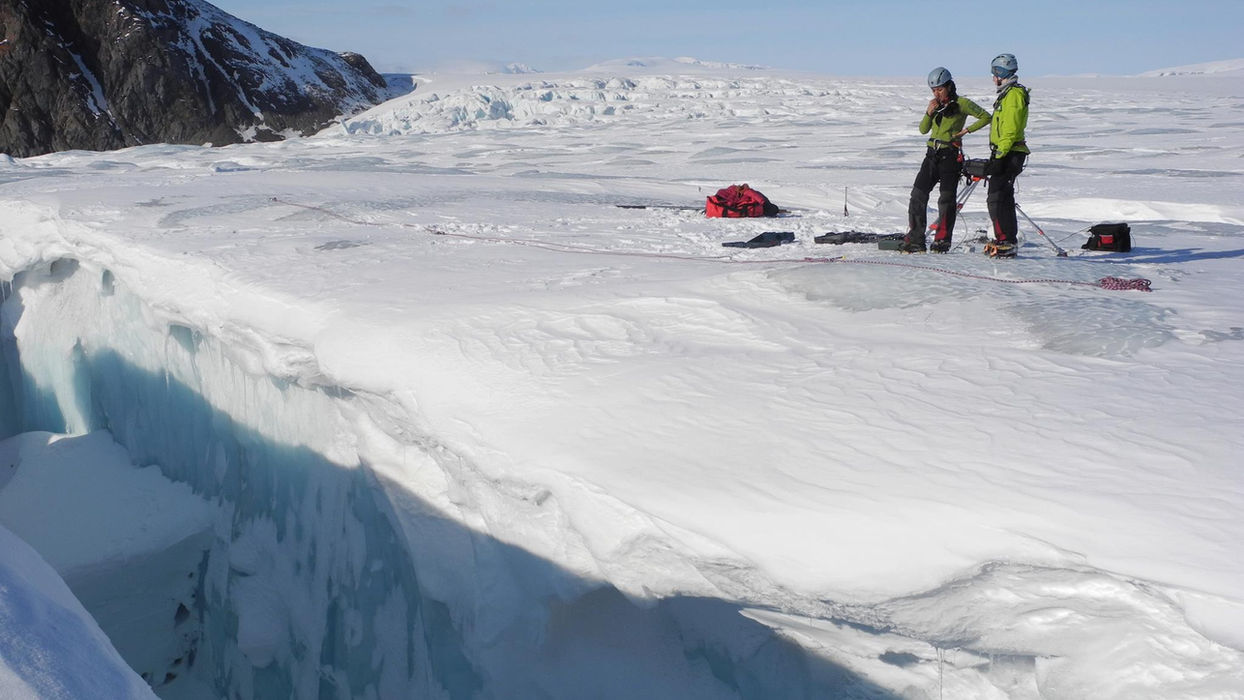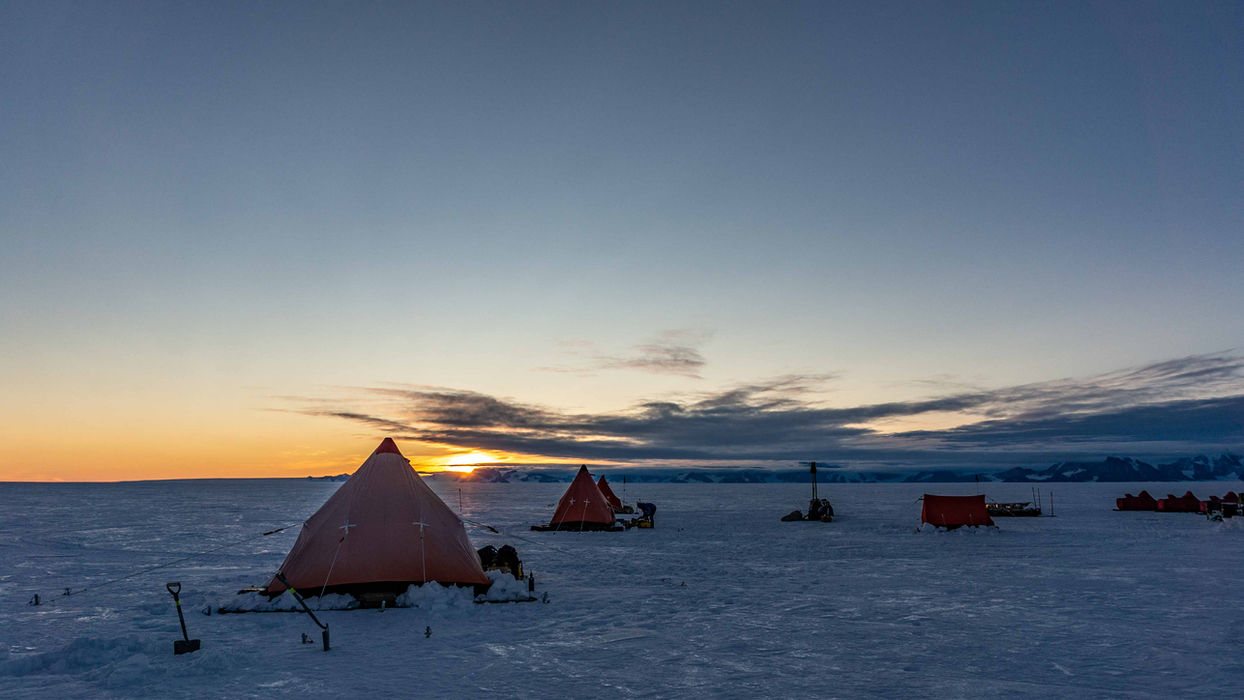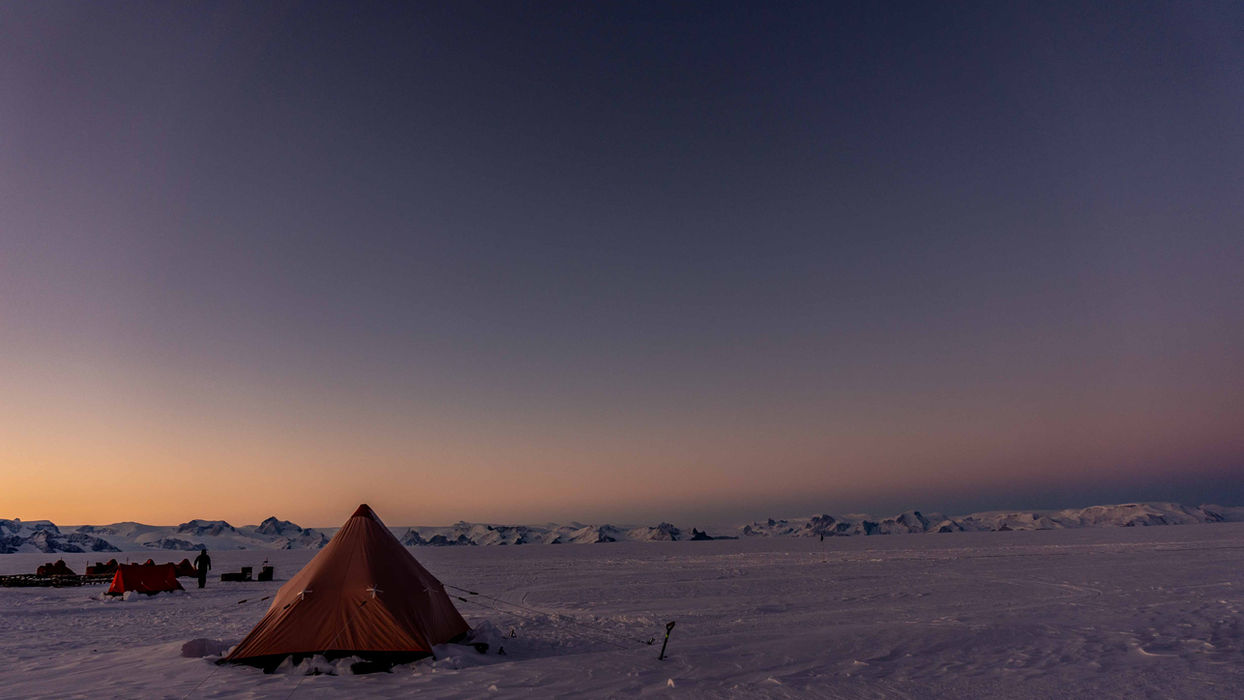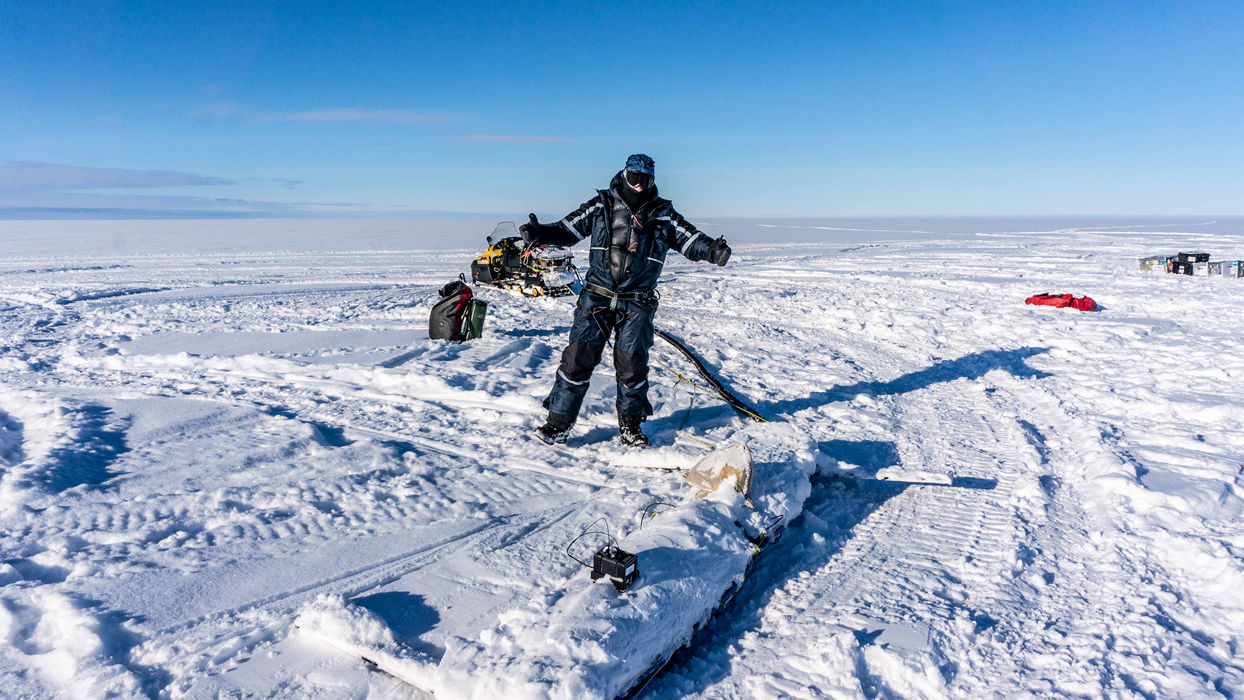
6 Weeks on Larsen C
ANTARCTICA 2015

Parler
October 2015.
Parler
ANTARCTICA 2015
From one Pole to Another.
Getting ready for the craziest week of my life. In a few days I'll be leaving Svalbard, the place that I have called home for the past 4 years, to travel to the other side of the planet. But first, there's one last important matter I need to take care of, and not a simple one: my PhD defense. Four years of intense labor compressed in one day of presentations in front of an international Jury. Luckily, my family has made the trip to the Arctic, providing me with all the support I need.
"I hope you're not too stressed, today is a big day for you" I jokingly told my supervisor. The day went so fast, I blinked and it was over. I never though that a PhD defense could be that much fun. We finished the day with a huge dinner with friends and family before going back home under a sky of northern lights. The success was bittersweet, in a couple of days I will leave the place I love the most, leave my job, my friends and my glaciers, without knowing when I will be back.
The reason why I am leaving Svalbard so soon is because another adventure is awaiting. Something I have been dreaming of my whole life, the ultimate voyage a glaciologist can take. I am going to ANTARCTICA!
A few months ago I got asked to join a team of glaciologists from the Welsh universities of Aberystwyth and Swansea. They were planning their second and last field campaign of their project investigating the Larsen C ice shelf, 6 weeks working and camping on the Antarctic peninsula. I could not believe my luck, this was going to be the trip of a lifetime.
Svalbard - Tromso, Tromso - Oslo, Oslo-London, London-Santiago, Santiago-Puerto Montt, Puerto Montt-Punta Arenas. 3 days, 7 flights, and 17 500 kilometers later, we were one leap away from the White Continent. The last flight is a special one, we are taking a Dash 7 operated by the British Antarctic Survey. After a short night in Punta, we're told that the weather the next day looks good, Antarctica is calling!
The flight took about 5H, nothing like what the first explorers had to endure! We were the first batch of scientists and station personnel to reach Rothera after the winter. To say that the flight was spectacular would be an understatement. The ocean became sea ice, the sea ice became land, land became mountains. We were literally glued to the windows of the plane, trying to take it all in. I had to pinch myself so many times, this was not a dream, I was flying over the Antarctic Peninsula! "Fasten your seatbelts, we're about to land". This is it, our new home for a week, we've made it to Rothera.
THE MOMENT HAS ARRIVED
Finally, we've received the green light to head to our designated field area, the Larsen C ice shelf. After months of meticulous planning, our excitement has reached its peak. Logistically, the drop-off day poses a significant challenge. We must transport the entire team and all the necessary equipment in one go, making it tricky to halt the operation once it commences. Safety is our top priority!
I happen to be the third person from my team to venture into the field, and to my surprise, I have an entire twin otter plane to myself, expertly piloted by Vicky. Little did I know that as a co-pilot with BAS (an unexpected promotion for me), the pilot might request me to take the controls for a few minutes when paperwork needs attention. So there I was, soaring over the trans-Antarctic mountains, flying a plane for the very first time! Let me tell you, I held my breath for a solid 40 minutes.
And there it was! Ice stretching as far as the eye can see, a vast, white expanse—the Larsen C ice shelf in all its glory! On the blindingly white surface, we could spot a tiny black dot. That was our first camp, looking quite vulnerable amidst the ice.
Upon landing, it became a race against time, as is often the case in Antarctica. Being prepared for sudden weather changes is crucial. We quickly set up the tents, gearing up for our first night on the Larsen C ice shelf. An important note: we reached the Larsen C ice shelf on October 29, 2015, marking the earliest arrival of a scientific team on the ice. Winter was gradually fading, but we were still expecting pretty cold conditions. The initial days on Larsen C were hectic, involving tasks like finding our designated locations, preparing research equipment, and more. Everything takes considerably longer in extreme environments—simple activities like getting out of bed, fixing breakfast, and layering up for the day took at least 2 or 3 hours!
One of our critical tasks was setting up the solar panels. We had large, rigid solar panels attached to metal poles, connected to hefty 80 Ah car batteries used for charging our toughbooks, sat phones, and research equipment. Here's where I made my worst mistake of the trip! While wiring one of the big batteries to the solar panel, I noticed a burning smell. In a split second, the entire cable was on fire. It turned out that someone had taped the + and - together at the other end of the cable the previous year—something I hadn't anticipated! The problem was compounded by the fact that we were inside the mess tent, and everything was made of highly flammable fabric. Fortunately, the strong Bradley grabbed the burning battery with his bare hands and threw it through the tent wall, creating a massive hole. Unfortunately, this also resulted in burns to Brad's hands. This incident marked the first use of our extensive first aid kit, just two days into a six-week-long expedition.
ROTHERA, HOME AWAY FROM HOME
Rothera is the main station from the British Antarctic Survey, found above the Antarctic Polar Circle on Adelaide Island. In the winter it is home to 22 winterers, and up to 100 people in the summer. We'll need some time there to pack our equipment for the field, and train for our great adventure with our two guides, Al and Bradley.
It felt great to be able to have a full week before the fieldwork. Plenty of time to get acclimatized to the polar conditions of Rothera, that is about the same latitude as Larsen C. The days were super busy, but also full of wonderful encounters and plenty, plenty of food. You're never more than 2H away from a snack or a meal at Rothera, just what we needed to fatten up a bit before the field.
After spending a few years working in Svalbard I really enjoyed learning about the way fieldwork is organised in Antarctica. In many ways I would it very old school. Where in the Arctic we always tried to have the latest sledges, tools, in Antarctica everything seem to date from another era. And the reason is, that is something breaks in the field in Antarctica, you cannot call anyone to come and help you out, you need to be able to fix it yourself.
We packed our P-bags (personal bag for sleeping), tested the stoves, set up the radio antenna, and did plenty of crevasse rescue exercises. Our two field assistants are incredible mountaineers and all-round field master jedis, keen to make sure we will not burn out tents down when boiling water. We also have some time to "walk around the point", the main easy hike that can be done around the station. There's still plenty of sea ice around the base, friendly wildlife and huge icebergs waiting for the thaw to wiggle their way out.
Our small group divided into three teams. On one side, we had Prof. Bryn Hubbard, the co-project leader, and Dr. Dave Ashmore focusing on drilling the ice shelf and installing sensors in the borehole. On the other side, there were Dr. Suzanne Bevan, my tentmate, Dr. Adam Booth, and myself, working on ground-penetrating radar and seismic measurements, among other tasks. To keep us in check, we had our two fantastic guides, Al Davies and Bradley Morrell.
Working in small teams is truly enjoyable. Everyone has to pull their weight to contribute to the project, leaving no room for egos or personal preferences. You must be prepared to dig holes for makeshift "toilets," melt snow for days, repair things broken by others, and handle food or fuel logistics. Every day brings new challenges, and this small team was incredible. With a wealth of experience and knowledge, I spent six weeks absorbing as much wisdom as I could from my teammates.
HOME AWAY FROM HOME
Our camp was mobile, investigating four different sites in six weeks. We spent a little over a week at each site. Our main guide, Al, perfected our camp setup. We followed the exact same plan every time, making it more comfortable for everyone: three sleeping tents, one large tunnel mess/equipment tent, one toilet tent, three skidoos, six sledges, and a runway marked all the way. Tent life on Larsen C was great. It was initially quite cold, averaging -25°C, but as spring gradually replaced winter, things became easier.
In terms of food, we were supplied with several "man food boxes" filled with British treasures to sustain us for 48 days. Breakfast consisted of muesli or oats with tea or coffee, lunch typically involved biscuits with peanut butter and jelly, and dinner was a welcome package of freeze-dried food. Throughout the day, we indulged in snacks like chocolate and cereal bars. Occasionally, we treated ourselves to a family dinner in the mess tent, with real food (usually a lot of meat) that Al and Brad had thoughtfully packed for us. These little feasts played a crucial role in boosting the team's morale.
SCIENCE ON LARSEN C
So, what were our scientific goals exactly? To start, we needed to grasp the significance of ice shelves and why they're crucial. Ice shelves are essentially composed of glacier ice that originated on the Antarctic continent and flows steadily toward the ocean. When the ice enters large natural embayments, it can float and create a solid "shelf" of ice, fed by land-based ice and occasionally giving rise to tabular icebergs.
Antarctica is surrounded by 15 significant ice shelves, now considered the safety barrier or guardians of Antarctica's ice sheet stability. If these ice shelves were to vanish, the land-based ice would accelerate, contributing even more to sea level rise. Unfortunately, these shelves seem highly sensitive to increases in water and air temperatures. Along the Antarctic Peninsula, we've witnessed the partial or complete collapse of ice shelves like Larsen A and Larsen B. Larsen C could be the next on the list, and to better evaluate its stability, we needed to investigate its structure.
We employed three primary research techniques to explore the strengths and weaknesses of the ice. First, a hot water drill enabled us to bore down to 100 meters, complemented by a televiewer—an advanced camera with LED lights that could capture images inside the borehole. Secondly, a ground-penetrating radar sent radio waves through the ice, offering insights into the ice structure, temperature, and water content. Lastly, we borrowed hundreds of seismometers to monitor artificial shockwaves traveling through the ice. Quite a collection of tools to work with!
After grappling with the final cold snap of winter, we finally kicked off our science program! Priority number one was melting enough snow to obtain 4000 liters of water—imagine the amount of digging we had to do! Once the drilling team secured enough water, our focus shifted to covering hundreds of kilometers with the radar and honing in on specific spots for seismics operations. The team handled the equipment with great care, having learned from the previous year's mishap when the televiewer got stuck in a borehole, and the radar system malfunctioned. Despite the usual challenges in field campaigns where plans often shift to B, C, or D, 2015 seemed to be a year where our prayers and sacrifices paid off, and we enjoyed splendid days of data acquisition with minimal problems.
The days and weeks flew by in a blur. My favorite aspect of the expedition was undoubtedly the long skidoo journeys with the radar, taking us to a different landscape far from camp. It provided the perfect opportunity for daydreaming. On one occasion, as we were concluding some radar profiles, the temperature plummeted. Al decided it was time to rush back to camp, and he was spot on—a massive storm hit, grounding us at camp for a straight 5 days. I was relieved to have made it back in time!
Over a six-week period, experiencing some adverse weather is inevitable. I can recall three instances when we had to spend several days in our tent, letting the storm rage outside. These were the most challenging times for me but also provided a great opportunity to learn how to stay occupied with what we had. I read Genghis Khan's biography three times, repaired my four pairs of gloves, and took dozens of walks in circles around camp. Overall, we were fortunate to have fantastic weather, and the rising temperatures filled us with joy.
After relocating camp three times, gathering some groundbreaking data, and nearly melting our snowmobiles, it was time to wrap up this field campaign. We had zero enthusiasm about returning to base, but we had no choice—a storm was on the horizon, and the British Antarctic Survey insisted on getting us safely back to Rothera before it hit Larsen C. We barely made it to the last camp, hurriedly collecting the final data, and the first plane was already touching down to pick us up. Leaving such an extraordinary place is always a poignant experience, uncertain if I'll ever have the chance to return. I'll forever be thankful for this incredible adventure!
THE WORLD'S BIGGEST ICEBERG
The 2015 field campaign marked just a chapter in our ongoing adventure with the ice shelf. Following our departure, we continued to monitor an enormous crevasse (rift) rapidly expanding through the eastern part of the ice shelf. To provide some perspective, this rift spanned hundreds of kilometers and reached depths of hundreds of meters—a colossal crevasse. During our fieldwork, we maintained a safe distance from the rift, receiving regular updates from our team back in the UK about its growth. The following year, a plane from the British Antarctic Survey flew over the rift, capturing some of the most spectacular footage ever:
Larsen C Ice Shelf : https://youtu.be/WAM0tZB0aIc?si=AyDFloiPAXI1kOpn
Why does this matter? Well, ice shelves calve large tabular icebergs all the time, this is the way they work. What is unusual about this, is that the rift was going to give birth to one of the largest icebergs ever! In July 2017, in the middle of winter, the rift extended all the way back towards the ocean giving birth to A68, an iceberg as big as the state of Delaware. Some models predicted that such a significant calving event could actually destabilize the rest of the shelf. Luckily, the ice shelf is still very much in one piece. The iceberg is now drifting acros the southern ocean, pushed by the powerful Antarctic circumpolar current.
Iceberg A-68 drifts away from Larsen-C Ice Shelf, Antarctica : https://youtu.be/8Aw0kHAnY28
MORE INFOS!
Here is the website we made for the Antarctica project:
























































